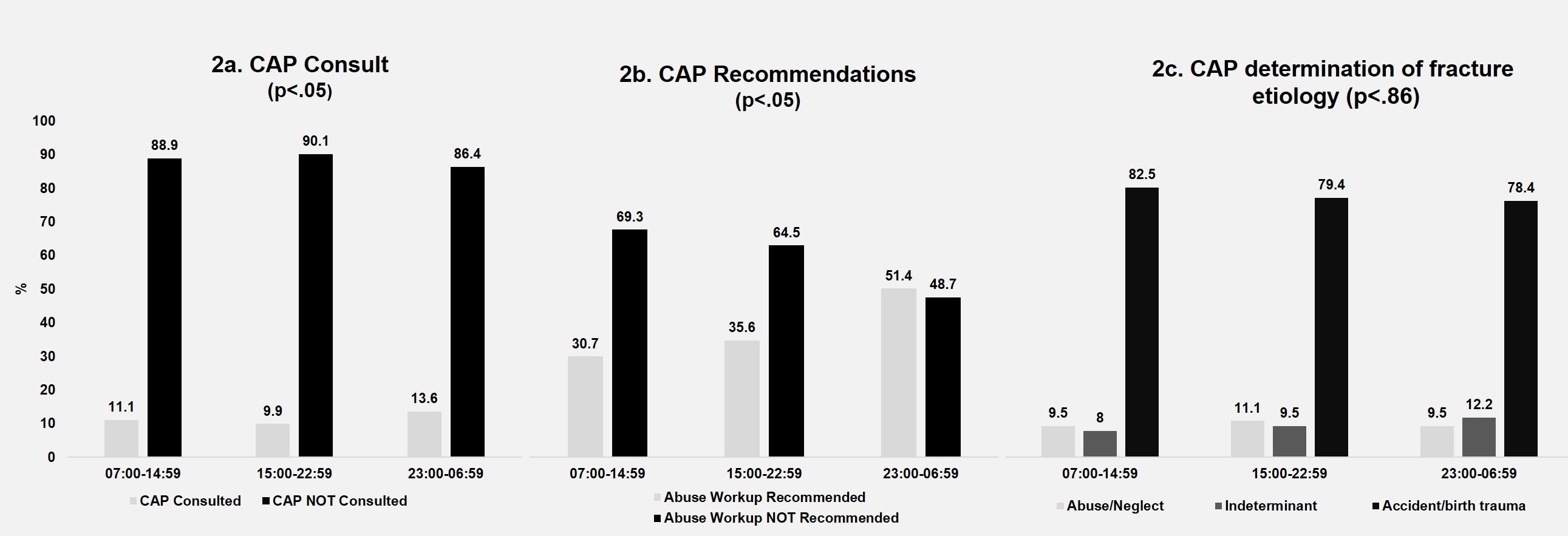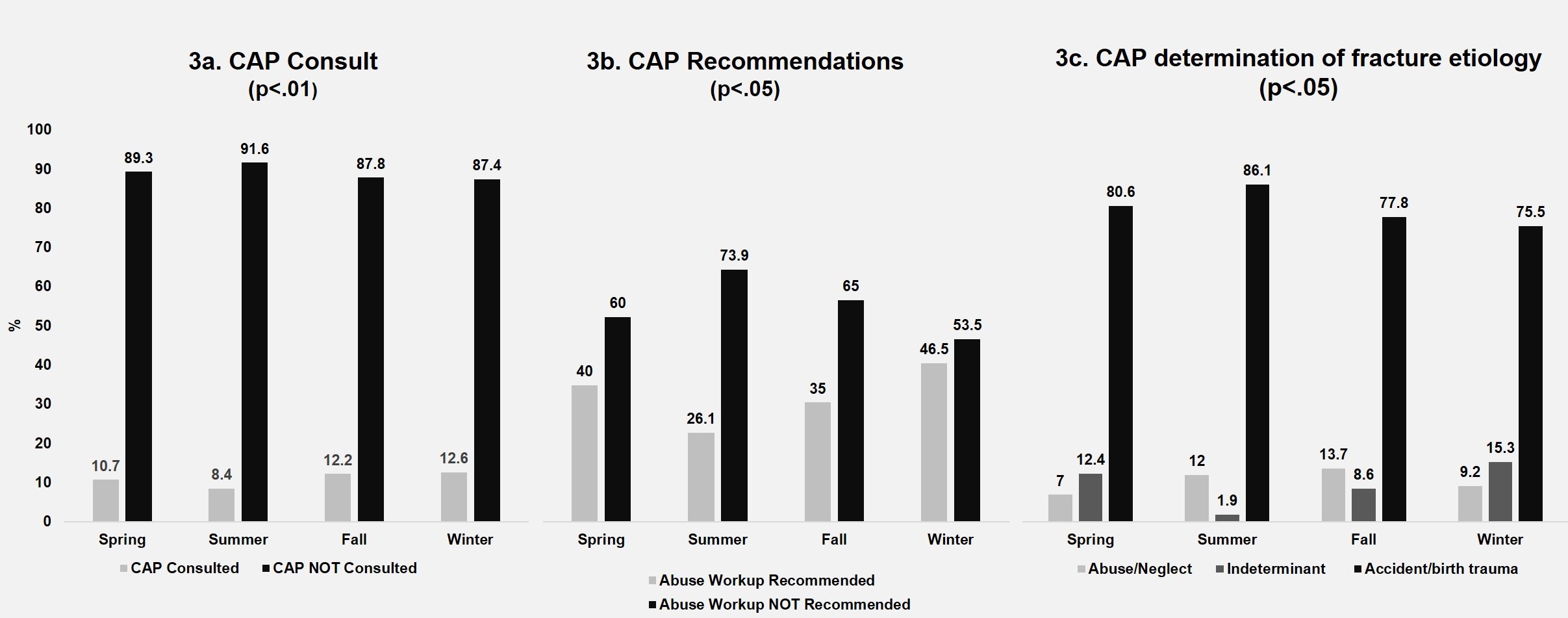Child Abuse & Neglect 2
Session: Child Abuse & Neglect 2
362 - Temporal Patterns in Emergency Department Presentations Among Children with Abusive Fractures
Sunday, April 27, 2025
8:30am - 10:45am HST
Publication Number: 362.6636
Grace J. Kim, The Warren Alpert Medical School of Brown University, Providence, RI, United States; Timmy Lin, The Warren Alpert Medical School of Brown University, Providence, RI, United States; William Rudman, The Warren Alpert Medical School of Brown University, Providence, RI, United States; Susan Duffy, Hasbro Childrens Hospital Brown University, Providence, RI, United States; Stephanie M. Ruest, Hasbro Children's Hospital at Rhode Island Hospital, Foxboro, MA, United States
.jpg)
Stephanie M. Ruest, MD, MPH, FAAP (she/her/hers)
Assistant Professor of Pediatrics and Emergency Medicine
Hasbro Children's Hospital at Rhode Island Hospital
Foxboro, Massachusetts, United States
Presenting Author(s)
Background: Fractures are the 2nd most common abusive injury, occurring mainly among children ≤5 years. Little is known about temporal patterns of ED presentations among children for whom abuse/neglect was considered and/or confirmed. Identification of temporal trends may help recognize children with higher risk for abuse.
Objective: To describe temporal patterns of ED presentations (e.g., time of day, day of week, season) among children ≤5 years with fracture diagnosis based on ED clinician consultation with a child abuse pediatrician (CAP), child abuse workup completion, and final fracture etiology determination.
Design/Methods: This is a retrospective observational study of children ≤5 years with a fracture seen at a pediatric ED between March 2015 and April 2023. Patient demographics were collected. Variables derived from date and time of presentation included: day of week, shift (0600-1449, 1500-2259, 2300-0559 based on nursing shifts), and season. Presence of CAP consultation, completion of abuse workup, and CAP determination of fracture etiology (e.g., abuse, accident) were abstracted. Descriptive statistics and chi-squared analyses were performed.
Results: 4,285 encounters among children ≤5 years (mean age 38.6 months, SD 20.0) with fractures were identified. 458 (10.7%) children had a CAP consult, among which, 168 (36.7%) had an abuse workup, 47 (10.3%) were diagnosed with abuse/neglect, 43 (9.4%) were considered indeterminant (concerning for abuse but cannot definitively diagnose), and 362 (79%) were accidental/birth trauma. There were significant differences in the distribution of ED encounters with and without a CAP consult by weekday vs weekend presentation (p <.01; higher consult proportion on weekdays and higher non-consult proportion on weekends), shift (p <.05; highest consult proportion and lowest non-consult proportion between 2300-0659), and season (p <.05, lowest consult proportion and highest non-consult proportion in summer). These significant differences remained when stratifying by presence of abuse workup and final fracture determination (p <.05 for all) except for shift presentation, which was no longer significant when stratified by the final outcome.
Conclusion(s): There are significant differences in temporal ED patterns by weekday vs weekend, shift, and season among children with fractures concerning for and confirmed to be abuse. While this study cannot determine the reasons for or generalizability of its findings, it raises questions about potential temporal-related risk factors for abuse that warrant further investigation.
Weekday versus weekend trends of encounters by: CAP consult, CAP recommendations, and fracture etiology
.jpg) Figure 1. 10.7% of encounters that had a child abuse pediatrics (CAP) consult (N=458 of 4285) ordered by ED clinicians. Among those, 36.7% with a CAP consult (N=168) had a child abuse workup per CAP recommendation. Out of all encounters, 1.1% (N=47) were determined to be due to abuse/neglect; 1% (N=43) were indeterminant, with the remaining encounters considered accidental or birth trauma. There was a difference in the distribution of weekday versus weekend presentations, with a higher proportion of encounters with a CAP consult and with an abuse workup recommended seen on weekdays versus weekends compared to those without a consult or abuse workup (1a, 1b). There was also a significant difference in the distribution of weekday versus weekend presentations by fracture etiology, with higher proportions of encounters determined to be due to abuse/neglect or indeterminant etiology seen on weekdays versus weekends compared to those determined to be accident/birth trauma (1c).
Figure 1. 10.7% of encounters that had a child abuse pediatrics (CAP) consult (N=458 of 4285) ordered by ED clinicians. Among those, 36.7% with a CAP consult (N=168) had a child abuse workup per CAP recommendation. Out of all encounters, 1.1% (N=47) were determined to be due to abuse/neglect; 1% (N=43) were indeterminant, with the remaining encounters considered accidental or birth trauma. There was a difference in the distribution of weekday versus weekend presentations, with a higher proportion of encounters with a CAP consult and with an abuse workup recommended seen on weekdays versus weekends compared to those without a consult or abuse workup (1a, 1b). There was also a significant difference in the distribution of weekday versus weekend presentations by fracture etiology, with higher proportions of encounters determined to be due to abuse/neglect or indeterminant etiology seen on weekdays versus weekends compared to those determined to be accident/birth trauma (1c). Shift trends of encounters by: CAP consult, CAP recommendations, and fracture etiology
 Figure 2. There were significant differences in the distribution of shift presentation among children with a CAP consult versus not, with a higher proportion of encounters with a CAP consult and with an abuse workup recommended presenting during the overnight shift (2300-0659) compared to those without a consult or abuse workup (2a, 2b). However, there was no significant difference in the distribution of shift presentation among those determined to be abuse or indeterminant compared to those determined to be accident/birth trauma (2c).
Figure 2. There were significant differences in the distribution of shift presentation among children with a CAP consult versus not, with a higher proportion of encounters with a CAP consult and with an abuse workup recommended presenting during the overnight shift (2300-0659) compared to those without a consult or abuse workup (2a, 2b). However, there was no significant difference in the distribution of shift presentation among those determined to be abuse or indeterminant compared to those determined to be accident/birth trauma (2c).Seasonal trends of encounters by: CAP consult, CAP recommendations, and fracture etiology
 children with a CAP consult versus not, with a higher proportion of encounters with a CAP consult and with an abuse workup recommended presenting during the winter compared to those without a consult or abuse workup (3a, 3b). There was also a significant difference in the distribution of season presentation among those determined to be abuse or indeterminant compared to those determined to be accident/birth trauma, with a higher proportion presenting during the winter (3c).
children with a CAP consult versus not, with a higher proportion of encounters with a CAP consult and with an abuse workup recommended presenting during the winter compared to those without a consult or abuse workup (3a, 3b). There was also a significant difference in the distribution of season presentation among those determined to be abuse or indeterminant compared to those determined to be accident/birth trauma, with a higher proportion presenting during the winter (3c).
